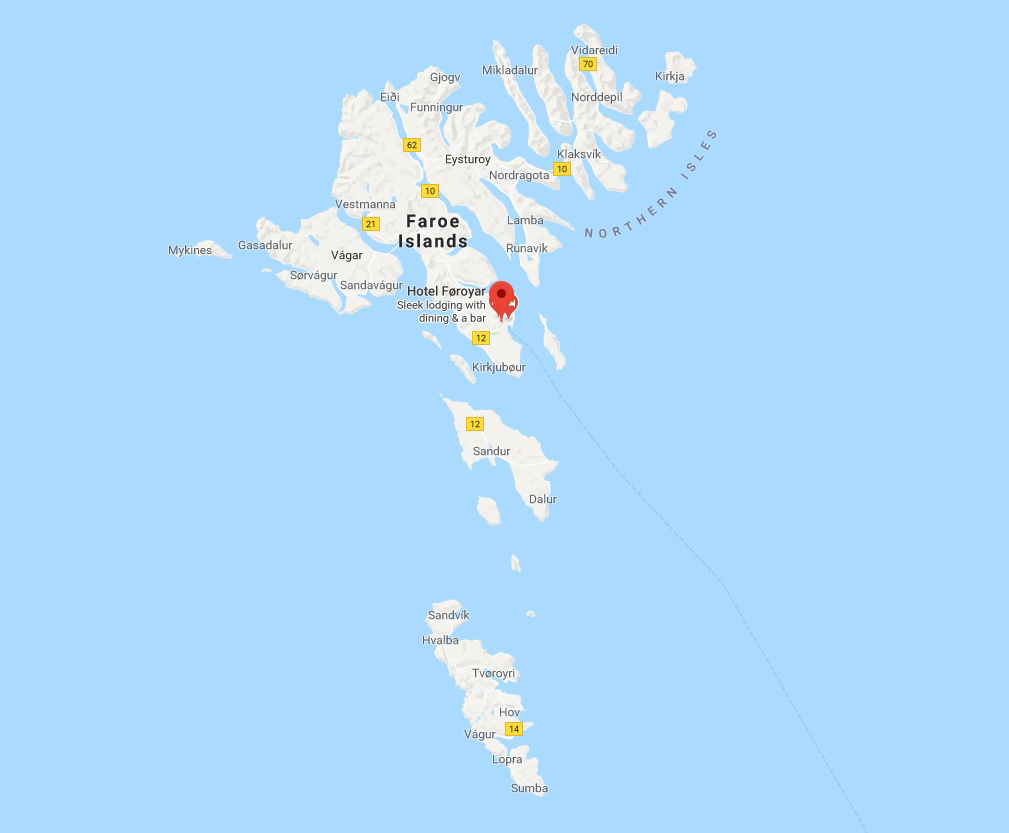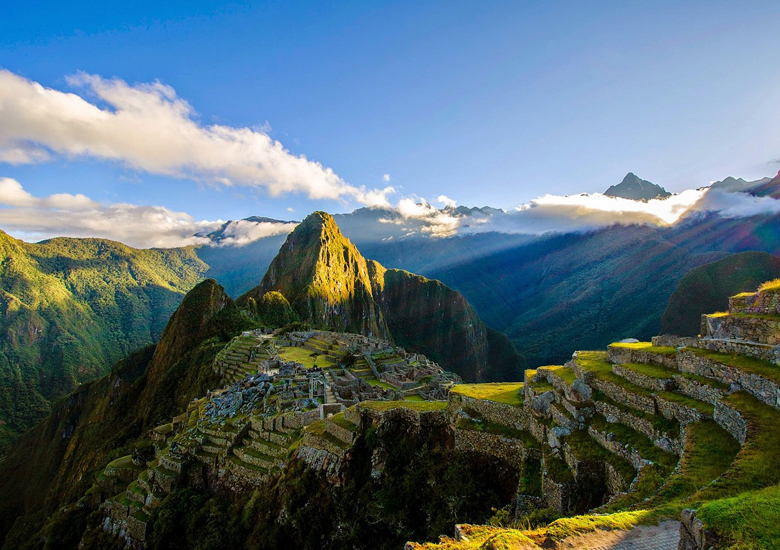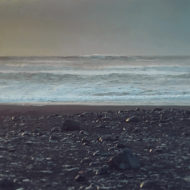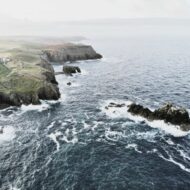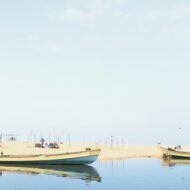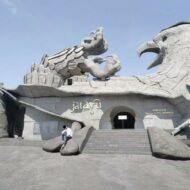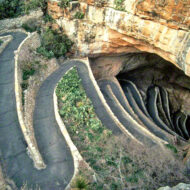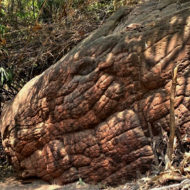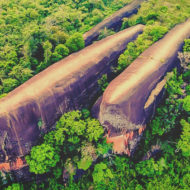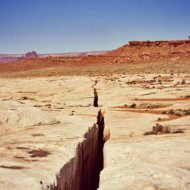Machu Picchu is a well-preserved ruined city in Peru. The Inca built the city in the 15th century at an altitude of 2430 meters on a ridge between the peaks of the Huayna Picchu and the mountain of the same name (Machu Picchu) in the Andes above the Urubamba valley of the Cusco region, 75 kilometers northwest of the city of Cusco. The terraced city was and is connected by a narrow mountain path with a small plant in the summit area of Huayna Picchu as well as relatively larger Inca paths with the former capital of the Inca Empire Cusco and the ruins of Llactapata.
UNESCO included Machu Picchu in the World Heritage List in 1983. In 2006, Machu Picchu was admitted to the List of International Historic Civil Engineering Landmarks by the American Society of Civil Engineers.
On July 7, 2007 Machu Picchu was selected as part of a private initiative, according to the organizers of 70 million people worldwide to one of the “new seven wonders of the world”. Both UNESCO as the official guardian of the World Heritage as z. For example, Egypt (Ancient Wonders of the World: Pyramids of Giza) distanced themselves from the election termed a “private campaign” without scientific criteria.
Access : Coordinates: -13.163333, -72.545556 / By plane : Aguas Calientes can be reached in just 30 minutes by helicopter. By car : There are no roads coming to the site.
By train : From Cusco there is a train to Aguas Calientes in about 3 hours. To get to Machu Picchu from the main Inca Trail the journey takes about three days. For this it is necessary to take the train up to km 82 of the Cusco-Aguas Calientes railway line, from where the journey begins on foot.
By bus : Some visitors take a local bus from Cusco to Ollantaytambo, which crosses the Sacred Valley of the Incas, and from there continue with a means of transport to the aforementioned km 82. On the spot they take the railway covering the remaining 32 km to Aguas Calientes.
If you arrive by train in Aguas Calientes, exit the station and continue more or less straight through the maze of craft stalls and onto a pedestrian bridge towards the bus departure area. Buses departing to the ruins are frequent at a price of USD 12 each way and USD 24 return for adults (May, 2015) starting at 05:30. There is often a queue, so whoever wants to get on the first bus should arrive at least 90 minutes early. The journey takes about 1/2 hour of slow switchbacks and up to the park. The buses leave when they are full, which means that they generally run quite regularly. In high season there may be a long queue for buses, so the return journey should be planned accordingly, in order not to miss train departures. It is advisable to book the train in advance, as the seats in the train run out quickly, especially those on the way back.
On foot :
From Aguas Calientes to reach the ruins it is possible to follow an itinerary of 8 km similar to the one in which the buses pass, which will take about 1.5 / 2 hours, and about an hour to go back. This route is mainly made up of stairs that connect the hairpin bends where the buses pass. It is a long and tiring walk but it is very rewarding, advisable around 05:00 when the gate opens downstream, to reach the summit before dawn. The descent is quite easy, just be careful when the passages are wet. Beware of bus drivers who rarely brake for pedestrians to pass.
The Inca trail is a great way to get there because you will see the city first through the Porta del Sole (instead of coming from below, as you do from Aguas Calientes). Both four and two day excursions are regulated by the government. Travelers should be fit enough to walk for days and sleep in tents. Every traveler needs to travel with a travel agency due to the rules and regulations of access to the park.
There are also other options available for excursions to Machu Picchu. It is important to know that the excursion on the Inca route can be carried out by a limited number of people every day, including porters. There is a substantial price to pay for this trek and it is necessary to reserve it in advance to get a place for the dates you are going to go.
Two other less expensive but equally good options are the Salcantay path and the Inca path in the jungle. Most Cuzco tourist agencies, if not all, offer these treks. The Salcantay is a five-day trek through the Salcantay mountain pass. The scenery is incredible and if you go in the rainy season you will be rewarded with dozens of waterfalls. Even if, in return, you will be wet yourself most of the time. The other option, the Inca walk in the jungle, is a three-day trek that starts with a guide on the road to the top of a mountain and then goes down by bike to the end. A full day of excursions follows the next day to Aguas Calientes.
Both of these alternatives can be booked a couple of days in advance when you arrive in Cuzco and you can find other much cheaper options to stay away from the crowd before arriving in Machu Picchu. Prices for the entire route are around 180/200 USD (January 2011). Once in Cuzco, compare the various tour operators and choose the one you feel most comfortable with. Some groups offer something more than others (e.g. including sleeping bag, etc.).
The Inca trail in the jungle is a group commercial tour, but there is also another route they use and that can also be used by independent travelers who wish to go it alone. Minivans and buses are cheap (15/30 sol) from the “Terminal Santiago” in Cuzco and will take you to the terminal of Santa Maria or to that of Santa Teresa. Santa Maria is further away from Aguas Calientes than Santa Teresa is, but it is a good option for those wishing to hike on an alternative Inca trail used locally. The walk will take you through mountains and small villages, as well as local farms and offers a splendid view of the valley. You can get to Santa Teresa on the same day and there are villages, like Huacayupana and Quellomayo, which offer an alternative view of local life and accommodation for those who can’t make it to Santa Teresa during the day. The walk from here to Santa Teresa takes place along the river from May to November and on the road during the rainy season, although it is advisable to seek advice before embarking on this path from December to April due to bad weather. From Santa Teresa to Hidroelectrica it is 25 minutes by taxi or minibus and from here you can walk to the flat trek in 2/3 hours to Aguas Calientes which is one of the most beautiful areas of the journey.
The Peruvian government has imposed a limit of 500 people per day on the Inca Trail. Permits are sold out well in advance, especially for the high season. Travelers must have a valid passport to be able to purchase a pass when booking. Many local tour operators offer alternative trekking options that allow similar excursions to be made in the area, most to visit other Inca ruins, not so well dug and brought to light, to end with the train journey to Machu Picchu. One of these possibilities is the Choquequirao path, which begins in Cacharo and ends in Los Loros or the Cachiccata path that begins in Racca and ends in Cachiccata.
Permits / Fees :
The rate and the purchase of tickets online are available on the official website of the government and at the ticket offices indicated on the same site, which unfortunately is incredibly difficult to use. Bookings made on the site only serve to give you the right to subsequently pay the tickets, so they do not guarantee entry the guarantee is obtained only after the effective payment has been completed. Bookings made online are valid only for 2-6 hours, depending on who requests them, and payment must be made to a bank (using the code on the reservation) or via one of the other payment methods, although it is not clear which these means. The safest option is to buy tickets at the Ministerio de Cultura in Cuzco or Aguas Calientes. Whatever you choose, make sure that the confusing website does not leave you with an invalid reservation, thus hindering your visit.
The entrance fee is USD 62 for Machu Picchu and 71 USD for Wayna Picchu (December 2014), with discounts for children and students with a valid ISIC card. To calculate your budget, don’t forget to include train and bus tickets. Eating on the site costs USD 40 (May, 2015) for a buffet lunch.
Most hostels can sell entry permits and bus tickets. Avoid buying them at the travel agency at the Ollantaytambo train station, as they do not sell the actual tickets, but a receipt that must be given to a person to receive the real tickets; thus risking to end up traveling around Aguas Calientes in search of this person. You can buy the ticket at the Aguas Calientes Ministerio de Cultura on 05: 30-21: 00.
Remember to bring your passport, as it is required at the time of entry. Some travelers have been able to enter with other forms of identification, but it is not a guarantee. There is a renowned kiosk that issues a stamp to show your friends and acquaintances that you have visited this place, even if it is technically illegal to mark your passport.
Only small backpacks are allowed in the park (no more than 20 liters), but there is a luggage room at the entrance, mostly used by the Inca walkers. If your backpack is checked, any food contained in it can be confiscated.
Only 2,500 people are allowed to enter Machu Picchu every day. The government website lists the number of tickets that are available for each day. In addition, visitors must purchase tickets for Huayna Picchu in advance and there is now an additional fee for their dedicated excursion.
Site : Layout : The Main Temple of the Machu Picchu / Fountains : series of small waterfalls filling 16 baths / Intihuatana stone : Intihuatana, the place when the sun gets tied, It was a religious construction, conformed of 4 sides, considering like the 4 cardinals points (north, south, east and west) located at the top of the sacred mountain,
Temple of the Sun : This is a semi-circular construction built over a strong rock, adapted to the natural environment, on the temple of the Sun there’s a tower with a trapezoidal window, built over a rock of granite / Temple of the Condor : A natural rock formation began to take shape millions of years ago and the Inca skillfully shaped the rock into the outspread wings of a condor in flight.
Sun Gate -Inti Punku : the main entrance to the Inca city of Machu Picchu. / Temple of the Three Windows / Solar Observatory / Sacrifice Center / The Mausoleum /
Stay Safe : The entrance to the site is expensive and particularly controlled, so it is difficult to come across pickpockets inside, however it is always a good idea not to let your guard down. Being a site full of hiking trails the most real risk is to fall more or less ruinously. The risks are greater in the rainy season when the soil becomes even more slippery than normal.
Activities : Open group treks / Archaeology Tours / Cultural Tours / Bus & Minivan Tours /
Hiking : Inca Trail : The most popular trek to Machu Picchu is the classic Inca Trail , Choquequirao Trek : The Choquequirao Trek is a 4-day to 9-day trek that visits Choquequirao ruins in the sacred valley off the Inkas near Cusko, total 58 km with return. Lares Trek : The Lares trek is a two- or three-day high-altitude hike in Cusco, Peru, starting near the village Lares, approximately 40 miles north of Cusco and 35 miles east of Machu Picchu. Salkantay Trek : The Salkantay Trek is a hiking in south America and an alternative to the traditional Inca Trail for reaching Machu Picchu.
Vilcabamba Trek : Vilcabamba Trek The rough distance of the trek is 30 miles or 48 kilometres , This path will take you from the last capital of the Inca ( the last refuge of the Inca Empire until it fell to the Spaniards in 1572) to the mysterious city of Machu Picchu!
Go next : Aguas Calientes / Ollantaytambo / Cusco / Vinicunca or Rainbow Mountain


